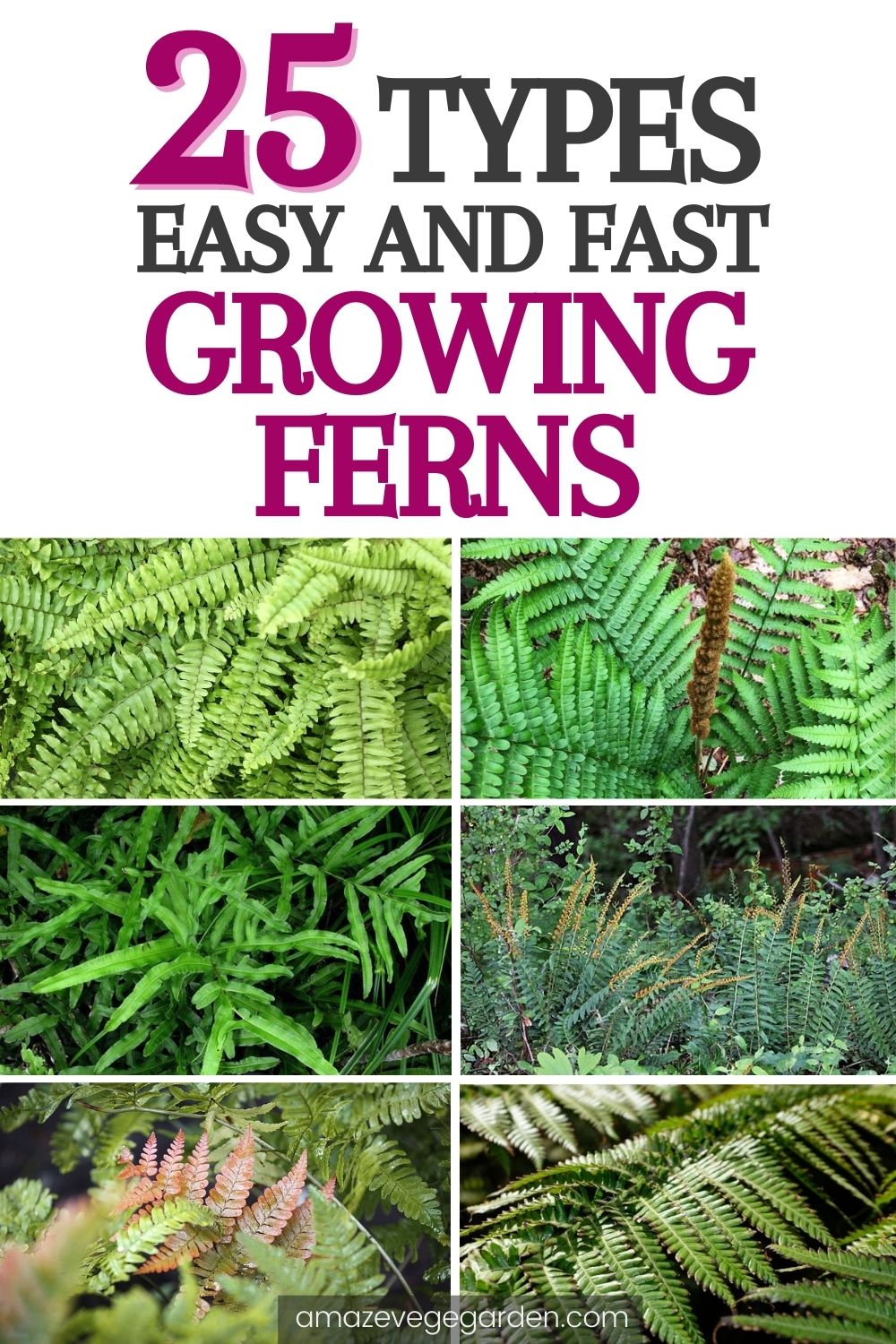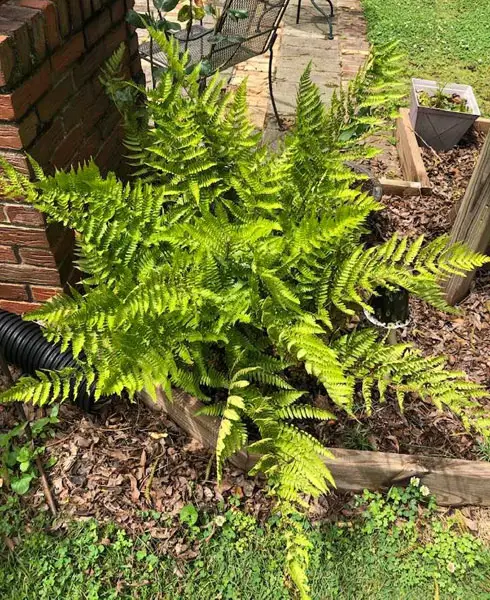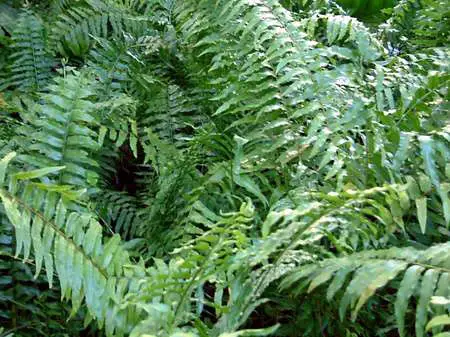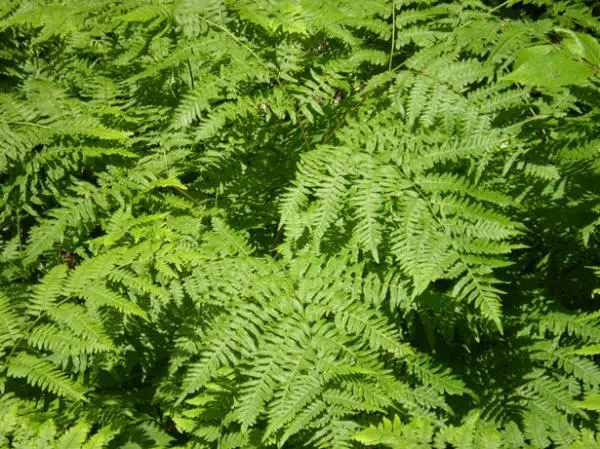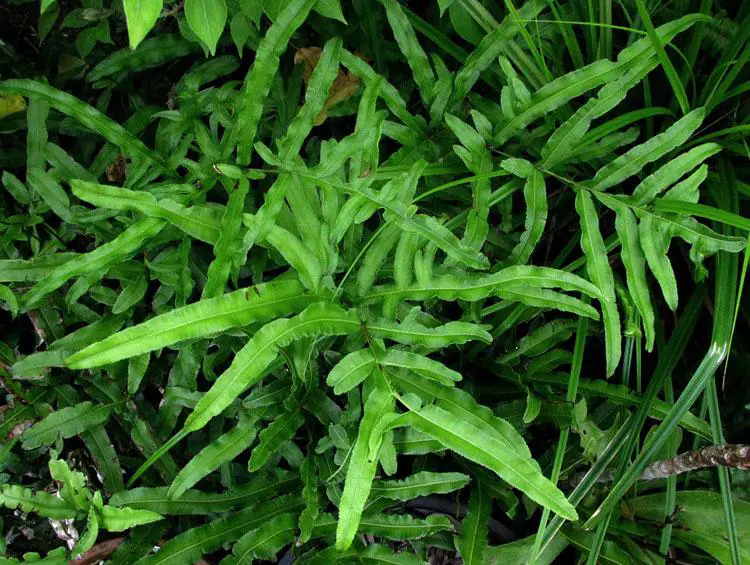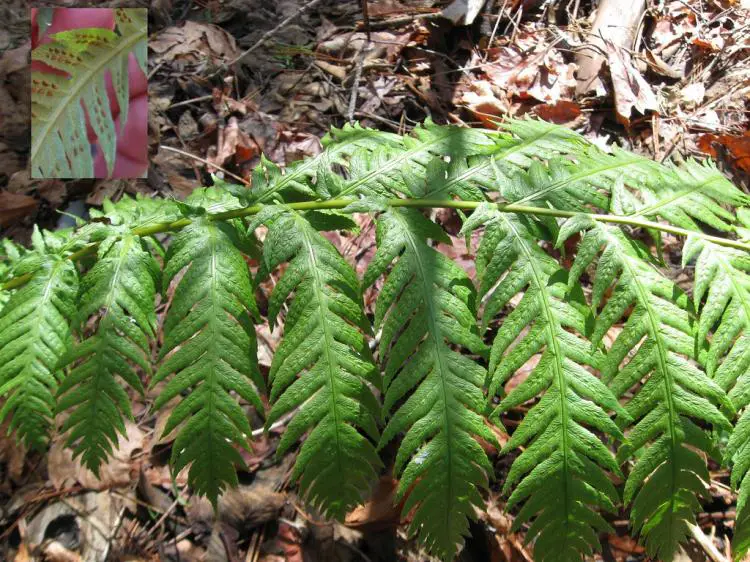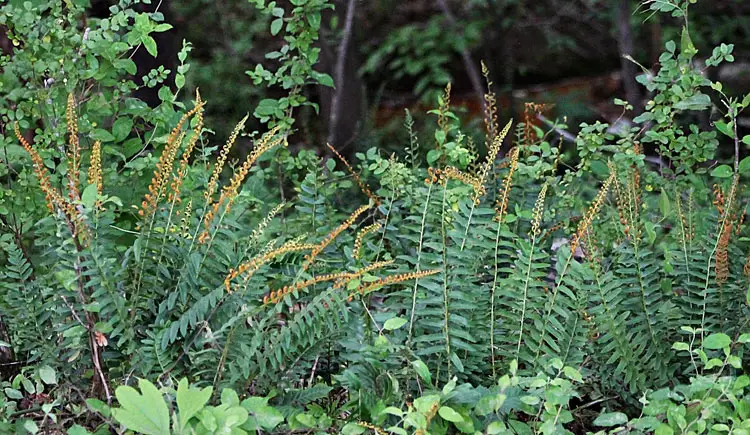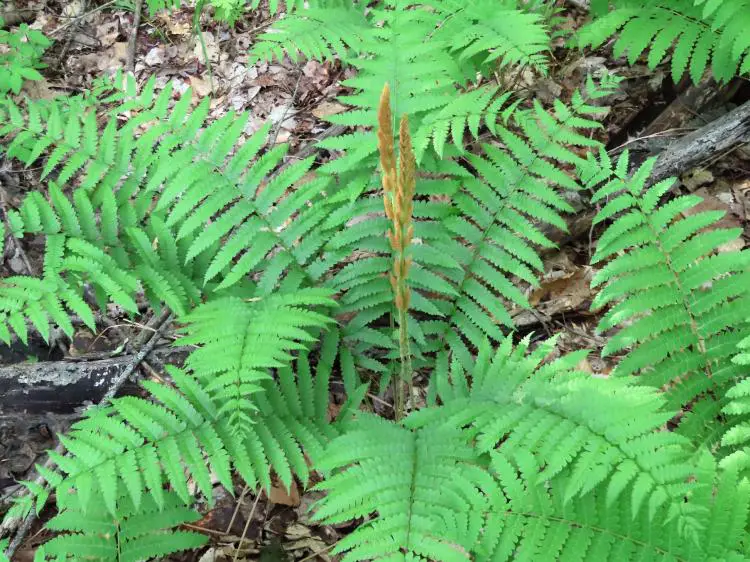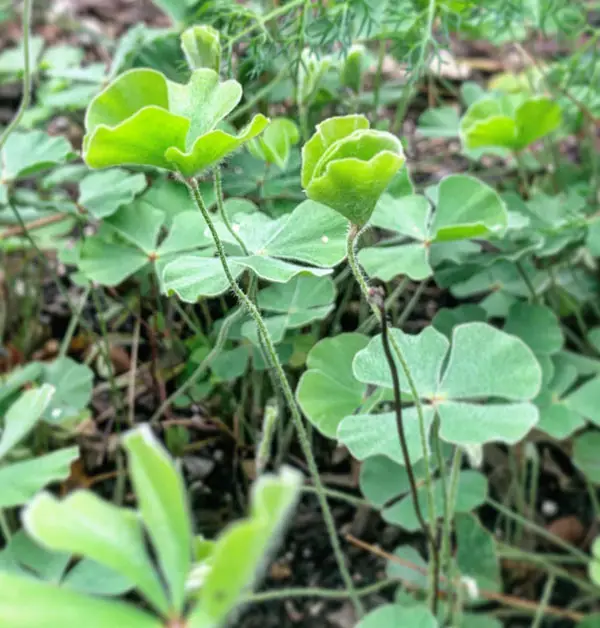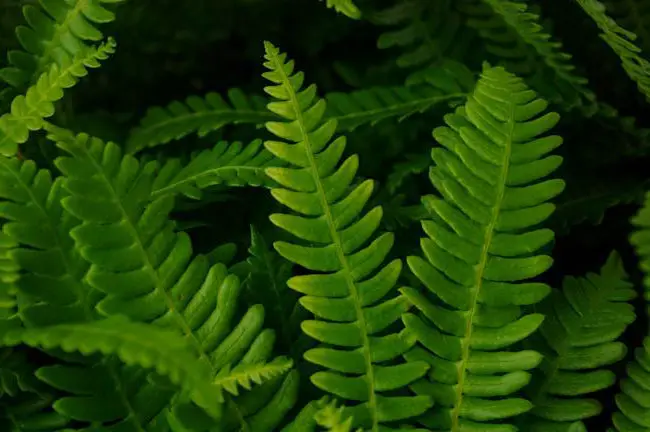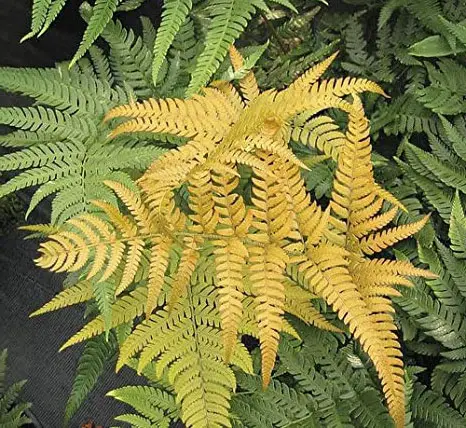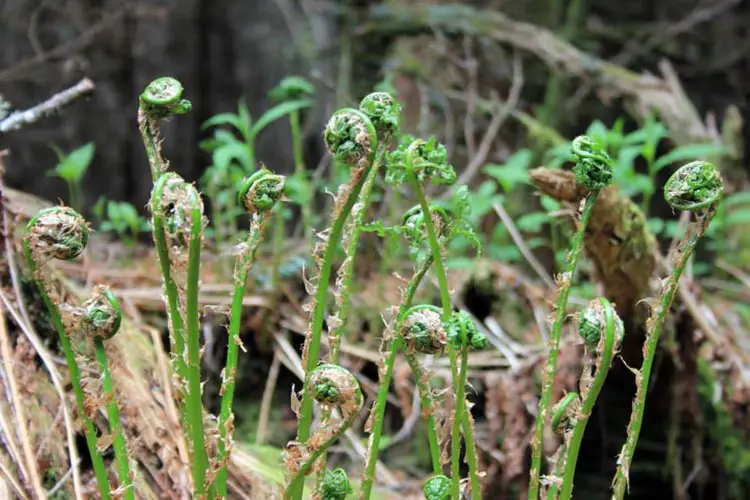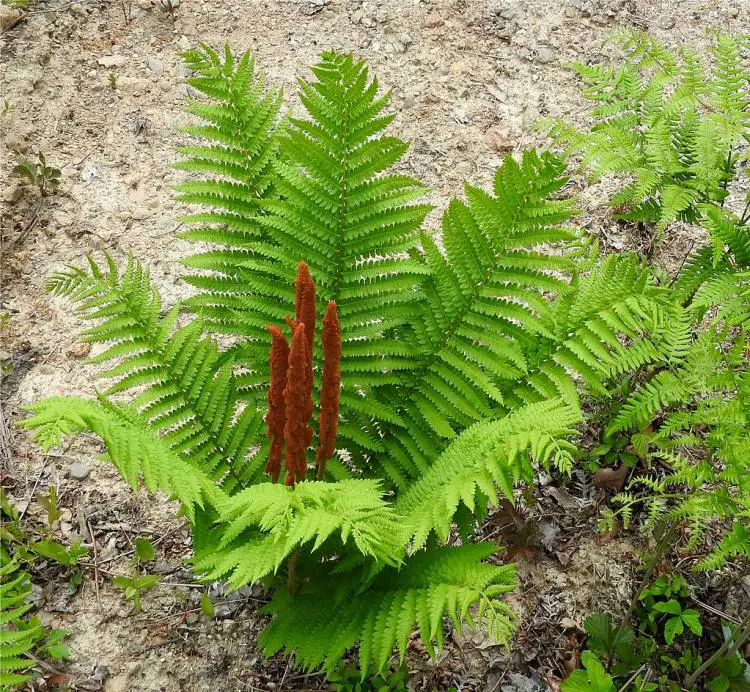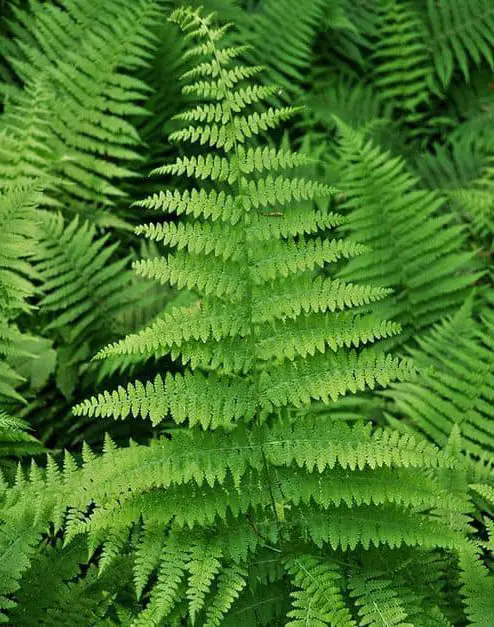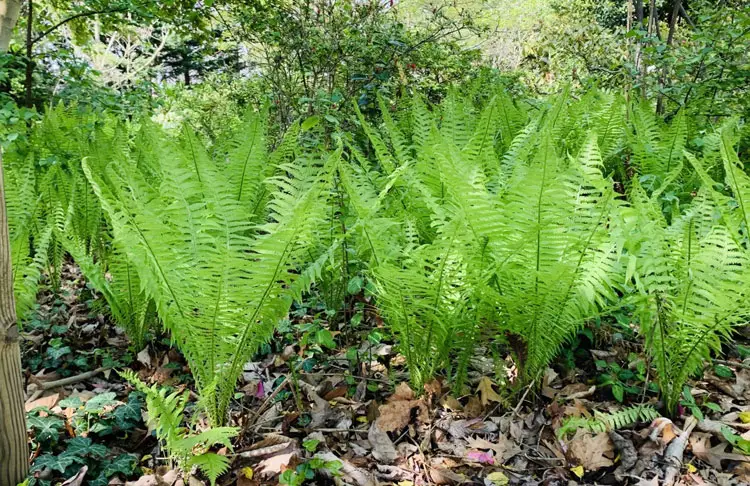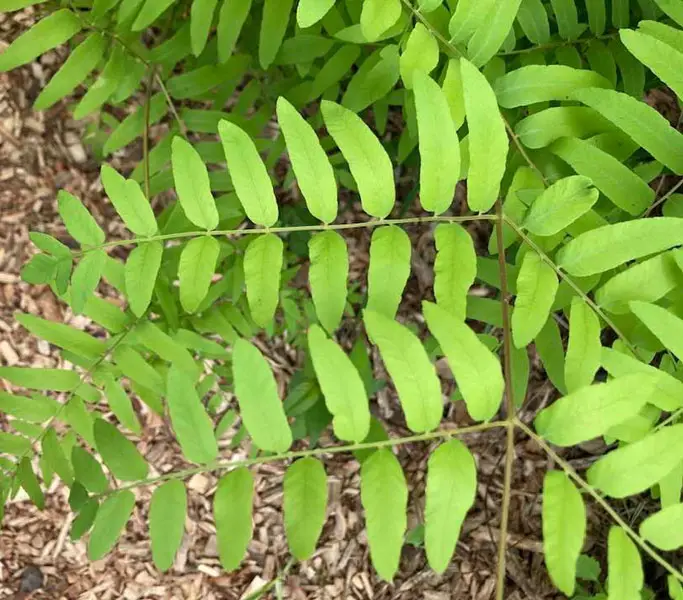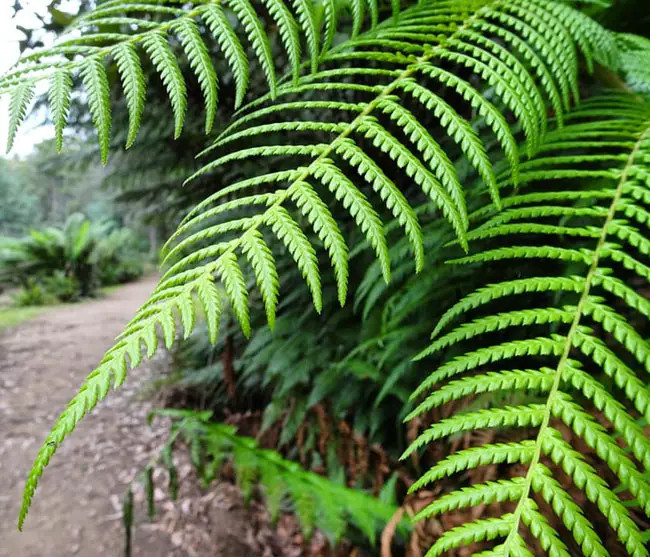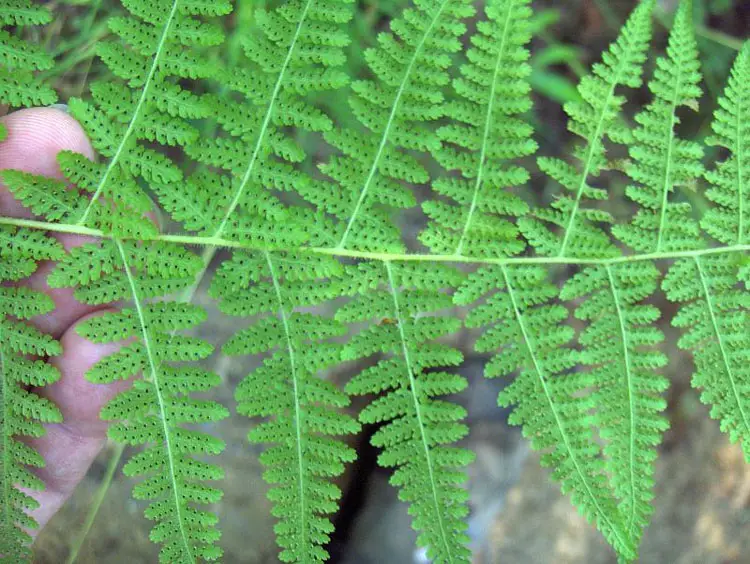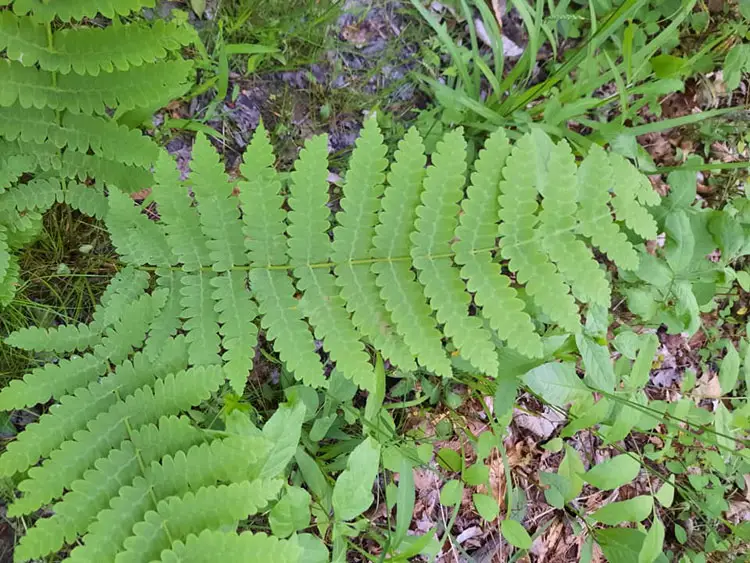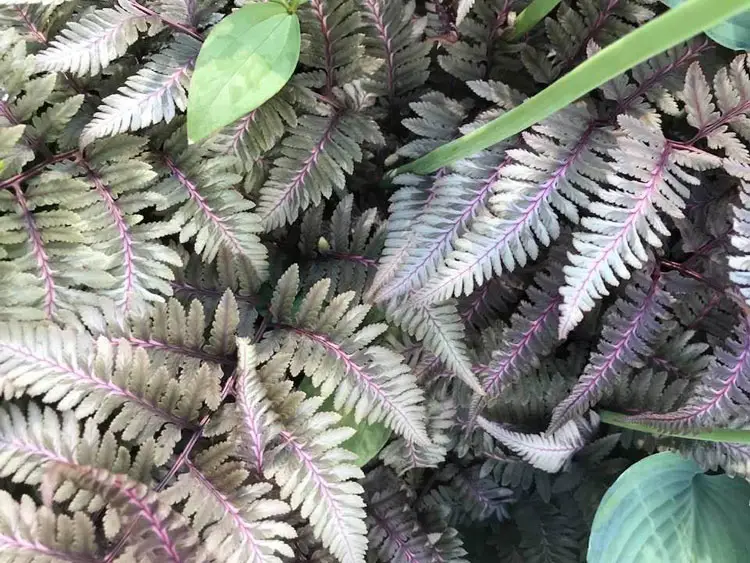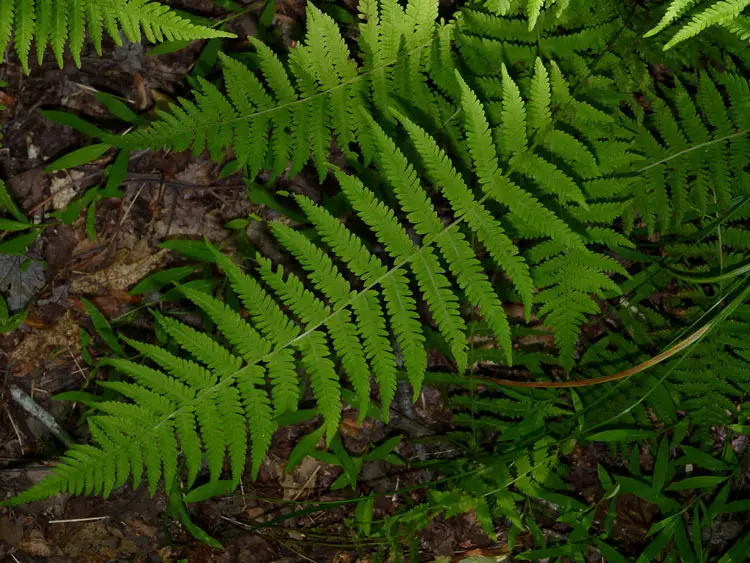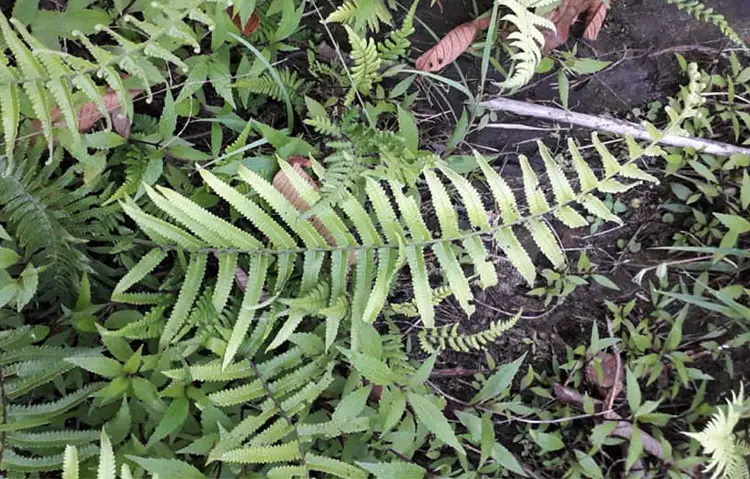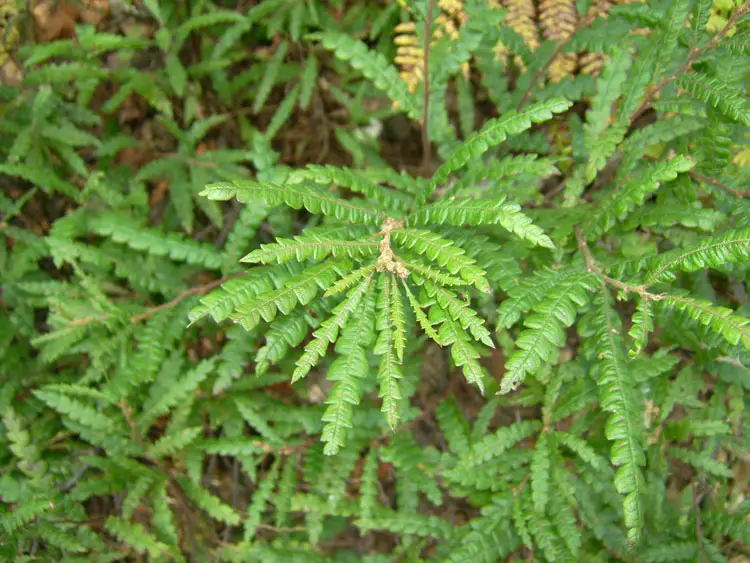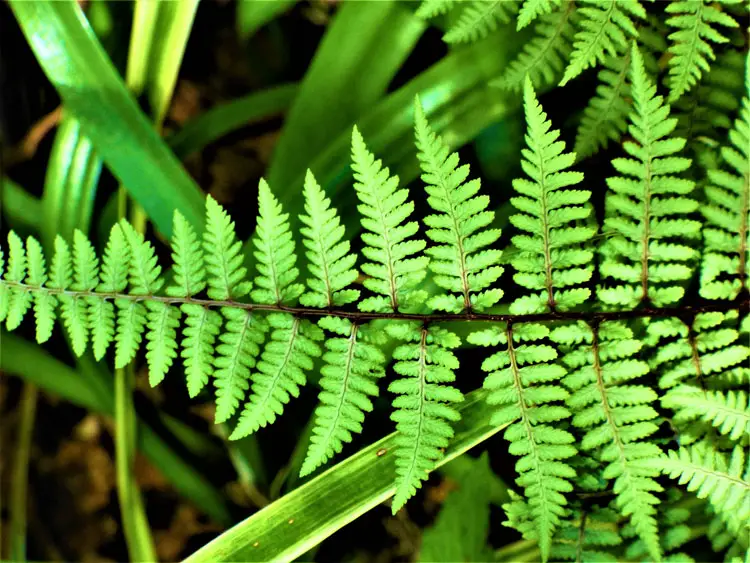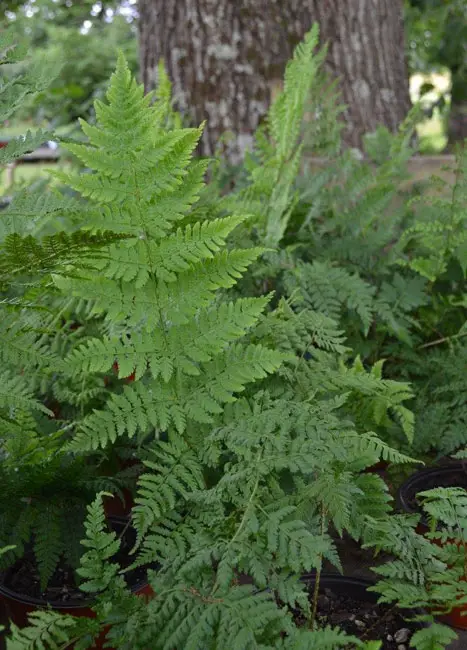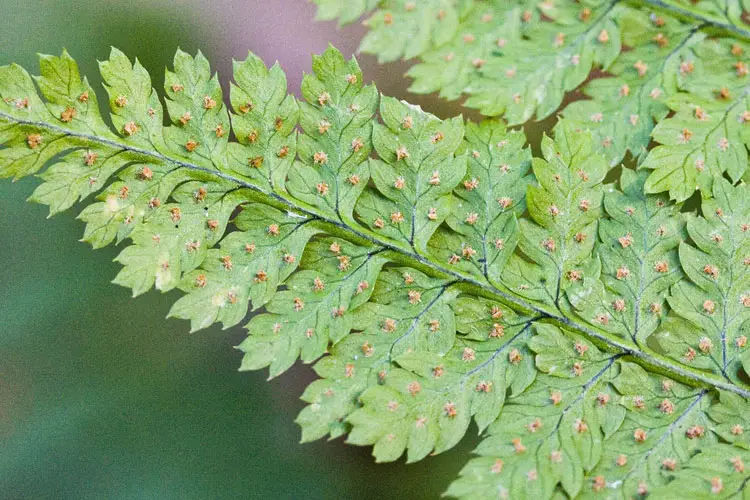Fern plants love shady areas, and they thrive in moist areas. Plant ferns in swamps or low-lying places and watch them grow by leaps and bounds. Ferns are also hardy in zones 4-9, and due to their ability to withstand drought and freezes, people in cooler climates than zones 4 have often had great success with them.
Native fern plants are best-sellers like the Christmas Fern. It’s an evergreen fern that the top foliage stays green on year-round. Another favorite is the fiddlehead fern. It’s an edible delicatessen in France and Europe for Salads and as a main course also.
If you love the ferns, you may want to try out to plant some in your garden. If you don’t know which fern you should choose to start with, now let me show you a list of different types of ferns that are fast-growing and easy for you to take care of.
1. Autumn Fern
The Autumn Fern is a bold and beautiful choice for shady borders and gardens. This is a dwarf growing fern that features papery fronds that put on a display of coppery-red color that matures into a deep green. This fern spreads out by the underground stems.
The Autumn Fern grows to be 1 to almost 3 feet tall, and it has an equal spread. This fern is a low-growing frilly fern that resembles a groundcover because it spreads along very close to the ground.
This fern is great to use to cover bare spots in shaded gardens or add some color to barren spots. The Autumn Fern is drought resistant and requires little maintenance once they are planted and established.
I wondered why they are called “autumn ferns” They are gorgeous in the autumn. The rest of the year, they are nice-but the fall-they are insanely beautiful.
- Zone 5-9
- Mature Height: 1.5-2.5 ft.
- Mature Width: 1.5-2.5 ft.
- Growth/Year: 1.5-2.5 ft.
- Sunlight: Partial to Full Shade
- Soil Conditions: Adaptable to various Soils
- Botanical Name: Dryopteris erythrosora
2. Boston Fern
Most commonly used house fern. The Boston Fern is great greenery to have 9. placed in hanging baskets outside on plant hangers or inside a plant stand. The Boston Fern does not like dry soil or full sun and can reach maximum heights of up to 5 feet and widths of 8 feet.
The Boston fern is one of the most popular ferns to most homeowners because it can grow to such maximum size, making it loved by many.
The Boston fern is oftentimes found in home gardening centers because it does well in homes when other ferns do not. It doesn’t seem to matter where Boston ferns are planted. They seem to thrive well.
- Zone 8-11
- Mature Height 5-10 ft
- Mature Width 4-8 ft
- Sunlight – partial sun to full shade
- Soil conditions – moist soil, well-drained
- Botanical Name: Nephrolepis Exaltata
3. Bracken Fern
Brackens fern- The brackens fern is a wonderful plant. This plant goes from a yellowish-green to a solid green. Often seen in the woods and a deciduous forest plant. This plant loves growing in wet soil and hates full sun but prefers partial to full shade. The plant grows up to 10 feet long in some places.
The Bracken Fern is a lovely fern to have on your property rather than around the pond, lake, stream, or in a flower bed. The Bracken fern is gorgeous because of its lovely green foliage and shiny, silky leaves.
This fern has small roots that are thin, long, and black and can sometimes reach into the ground up to 20 inches. The Bracken Fern is one of the first ferns normally killed by the frost because it hates the colder temperatures, and the body cannot tolerate it.
- Zone 3-11
- Mature Height: 6-10 ft.
- Mature Width: 3-6 ft.
- Growth/Year: 6-10 ft.
- Sunlight: Full Sun to Partial Shade
- Soil Conditions: Adaptable to various Soils
- Botanical Name: Dryopteris erythrosora
4. Brake Fern
Brake fern is a nice plant. Often found in Texas or dry climates. This fern grows well in rocks or any place that is dry and humid. This fern loves sandstone because of the high pH content it has in it. This plant prefers shade or partial sun. It grows about 3 feet high and a foot wide.
Why not plant a Brake fern on your property or your landscape? The Brake Fern is a lovely fern that can be grown almost anywhere rather it is in the shade or is around your walkway or flower bed. The Brake Fern is a great asset to have on your property.
This fern has small roots that are thin, long, and black and can sometimes reach into the ground up to 20 inches. The Brake Fern is one of the first ferns normally killed by the frost because it hates the colder temperatures, and the body cannot tolerate it.
- Zone 6-10
- Mature Height: 1-2 ft.
- Mature Width: 1-2 ft.
- Growth/Year: 1-2 ft.
- Sunlight: Partial to Full Shade
- Soil Conditions: Adaptable to various Soils
- Botanical Name: Pellaea Ovata
5. Chain Fern
The chain fern is a very unique-looking plant. This type of fern does well in zone 8-9 and is Native to North America. The chain fern is a very deciduous fern that has green foliage and loves partial to full shade.
This fern can be found on the banks of creeks and ponds and along banks where the soil is well damp. This plant hates the sun and grows in partial sun or shade. The plant grows about 4 feet tall but can grow on occasion to 9 feet long.
- Zone 7-10
- Mature Height: 1.5-2 ft.
- Mature Width: 1-1.5 ft.
- Growth/Year: 1.5-2 ft.
- Sunlight: Partial to Full Shade
- Soil Conditions: Adaptable to various Soils
- Botanical Name: Woodwardia Areolata
6. Christmas Fern
Native to North America, Nova Scotia, and Maine, this fern is an evergreen fern and can often be called the Christmas fern. This fern stays green all winter. Commonly known as the woodland fern. It is native to the west coast. This fern is commonly found growing under Oak trees and in woodland forests with moist soil and lots of shade.
- Zone 3-9
- Mature Height: 1.2-1.5 ft.
- Mature Width: 1-2 ft.
- Sunlight: Partial to Full Shade
- Soil Conditions: Moist, cool, well-drained soil in shade
- Botanical Name: Polystichum Acrostichoides
7. Cinnamon Fern
Cinnamon fern is Connecticut’s largest fern. This fern has huge leaves that can grow up to 6 feet long and a foot wide. The Cinnamon fern is a light green color with a cinnamon-colored bloom or bud in the center. The plant enjoys partial sun or full shade.
Cinnamon fern is Connecticut’s largest fern. The Cinnamon Fern closely resembles the Ostrich Ferns, but this fern has some very distinct differences. This fern has huge leaves that can grow up to 6 feet long and a foot wide.
The Cinnamon fern is a light green color with a cinnamon-colored bloom or bud in the center. The plant enjoys partial sun or full shade. The Cinnamon Fern is commonly used as a backdrop in larger gardens.
- Zone 4-8
- Mature Height: 2 ft – 5 ft
- Mature Width: 2 ft – 3 ft
- Sunlight: Full Sun to Partial Shade
- Soil Conditions: Moist but Well-Drained
- Botanical Name: Osmunda Cinnamomea
8. Clover Ground Fern
Clover Ferns are beautiful plants. The Clover Ferns are mostly found underneath pine trees. Clover Ferns are a great food source for deer, especially in the cold months. The plant grows about 3 feet high.
- Zone 6-10
- Mature Height: 8″ – 12″
- Mature Width: 1″ – 2″
- Sunlight: Part sun to shade
- Soil Conditions: moist, dry, or drainage
- Botanical Name: Elaginella Kraussiana Aurea
9. Deer Fern
Deer fern is a beautiful plant. This plant is called a deer fern because deer stay near it for food and shelter. The deer fern is mostly found underneath pine trees. Deer fern is a great food source for deer, especially in the cold months. The plant grows about 3 feet high.
- Zone 5-8
- Mature Height: 1-2 ft.
- Mature Width: 1-2 ft.
- Growth/Year: 1-2 ft.
- Sunlight: Full to Partial Sun
- Soil Conditions: Adaptable to various Soils
- Botanical Name: Blechnum spicant
10. Golden Fern
The golden fern is a nice plant to have around the house. This plant is green all year long. It gets its name because of the golden color at the tip of its leaves. The Golden fern is a great fern to have growing around water gardens or in areas that get mostly shade. The plant grows about 3 feet tall.
The Golden fern is unlike other ferns. It has a deep, golden color that makes it stand out among the rest. The Golden fern can reach a massive height of up to 4-6 feet and stand as tall as wide. The Golden Fern does well in moist soil types and loves and thrives on shade as well as well-drained soils.
These ferns love the water groves and salty marshes because of the water. The Golden Fern’s growth rate is moderate but loved by many because it looks great planted in landscapes, along river banks, or around ponds.
- Zone 3-8
- Mature Height: 3 ft – 4 ft
- Mature Width: 3 ft – 4 ft
- Sunlight: Partial shade
- Soil Conditions: Moderately fertile, moist, well-drained, humusy
- Botanical Name: Acrostichum Aureum
11. Fiddlehead Fern
The fiddlehead fern is a nice winter plant. Some cultures harvest the small plants to eat as a vegetable. It blooms and comes up in early spring—a good source of vitamin A and C. The plant needs to be cooked and can’t be eaten raw, or it can cause sickness.
This fern normally sticks around until the last frost. The plant grows about 4 feet long. The plant also prefers partial shade to keep it moist.
- Zone 3-7
- Mature Height: 3-6 ft.
- Mature Width: 5-8 ft.
- Growth/Year: 3-6 ft.
- Sunlight: Partial to Full Shade
- Soil Conditions: Adaptable to various Soils
- Botanical Name: Matteuccia Struthiopteris
12. Giant Cinnamon Fern
Giant cinnamon ferns are found in boggy moist areas on the shaded ledges and streams. These usually grow in clumps. The fronds are generally of two types- the small ones of cinnamon and the big green ferns.
It has got its name from small and young fronds that start from bright green color and then slowly turn in cinnamon color. The small ferns give great contrasts to deep green fronds. Like most ferns, the cinnamon ferns also prefer shady areas, but they grow to their fullest with sun and moisture.
These ferns, unlike all others, are capable of tolerating floods and can grow in submerged and wet soil. After boiling little fronds, humans can consume them. A lot of people also use these as tasty delectable. These ferns contain rhizomes and are a kind of underground stems that grow into full plants.
This is one of the ways of propagation of these plants. These ferns are vital to the ecosystem. They provide shelter to many small animals such as insects, snakes, squirrels, and birds. These ferns grow alongside other plants like near wild strawberry red maple, greenbrier, and oak trees.
These cinnamon ferns are considered to be great for shade gardens. They add beauty to the wooded landscape ponds and streams. If you have green fingers, you can buy the giant cinnamon ferns online too. Get the best quality ferns for adorning your garden.
You will be able to buy these ferns with the help of experts. There is no dearth of variety of these ferns. Get one of them at wholesale prices for your garden.
This plant gets its name because it looks likes someone sprinkled cinnamon on it. This plant is black on the bottom of its stem. The giant cinnamon fern has a slight cinnamon aroma when a leaf is broken or bruised.
- Zone 4-8
- Mature Height: 24-60 inches
- Mature Width: 24-30 inches
- Growth/Year: 24-60 inches
- Sunlight: Partial to Full Shade
- Soil Conditions: Grows anywhere with ample moisture
- Botanical Name: Osmunda Cinnamomea
13. Leatherwood Fern
The giant leatherwood fern is a wonderful plant. This plant has leathery leaves. The leatherwood fern stays orange and red all year long. The leatherwood fern loves partial sun to partial shade. The plant grows about 4 feet long, with some giants reaching 10 feet long.
The Leatherwood Fern gets its name because its rich orange and red color looks very similar to leather sitting upon the forest or around a pond or stream bed.
This plant has leathery leaves and stays green all year long. The Leatherwood fern loves shade and grows well in places that get a lot of shade and can keep moist soil. The Leatherwood fern gets its name due to the leaves’ rich red and orange color, which makes it look very similar to leather.
Once you see the Leatherwood Fern growing in a forest, on a water bed, or anywhere that there is moist, wet soil, you will never want any other plant but a leatherwood fern growing in your yard.
- Zone 3-8
- Mature Height: 1.5-2 ft.
- Mature Width: 1.5-2 ft.
- Growth/Year: 1.5-2 ft.
- Sunlight: Partial to Full Shade
- Soil Conditions: Adaptable to various Soils
- Botanical Name: Dryopteris Marginalis
14. Giant Ostrich Fern
This plant gets its name because it is gigantic, like an ostrich. The Ostrich fern gets massively wide and can reach widths of up to 8-10 feet, and the leaves can grow at lengths of up to 6 feet long. The Giant Ostrich fern is a great fern to grow along creek beds or riverbeds because it loves moist wet soil.
- Zone 2-8
- Mature Height: 4-6 ft.
- Mature Width: 1-2 ft.
- Growth/Year: 4-6 ft.
- Sunlight: Partial to Full Shade
- Soil Conditions: Adaptable to various Soils
- Botanical Name: Athyrium Dyemocarpon
15. Giant Royal Fern Plant
The giant royal fern is a fern that has both male and female leaves on it. It is often called the Royal Fern. The giant royal fern has very long fronds, which have lance-shaped leaves.
This fern is native to Europe, Africa, and Asia. The plant prefers shaded areas, highly acidic, and very wet soils. When the giant royal fern has been properly cared for, it will grow to be about 4 feet high. Many gardeners use the giant royal fern as an accent in gardens or even containers.
- Zone 3-8
- Mature Height: 2 ft – 6 ft
- Mature Width: 2 ft – 3 ft
- Sunlight: Full sun
- Soil Conditions: Fertile, moist, well-drained, humus-rich
- Botonical Name: Osmunda Regalis
16. Glade Fern
The glade fern is a wonderful plant. This plant is native to eastern North America and Europe. This plant does not need too much water just until the leaves are damp. This fern loves shady areas such as woody forests and underneath trees. The plant grows about 4 feet long.
- Zone 4-8
- Mature Height: 4 ft – 5 ft
- Mature Width: 4 ft – 6 ft
- Sunlight: Full to partial shade
- Soil Conditions: Adaptable to various Soils
- Botanical Name: Homalosorus Pycnocarpos
17. Hay-Scented Fern
It gets its name honest because when this fern is bruised, it smells like hay. The Hay Scented fern can grow in clumps of up to 12-18 inches and is a deciduous plant. The Hay Scented Fern grows well in partial shade and moist soil.
If these plant fondles get crushed or broken, you can smell a scent of hay thus, giving it its name. Many homeowners love Ferns because it doesn’t seem to matter where they are planted. They give off a look of appeal and elegance.
- Zone 4-9
- Mature Height: 1.5-2 ft.
- Mature Width: 2-3 ft.
- Growth/Year: 1.5-2 ft.
- Sunlight: Partial to Full Shade
- Soil Conditions: Adaptable to various Soils
- Botanical Name: Dennstaedtia Punctilobula
18. Interrupted Fern
The interrupted fern is different than most ferns. This plant gets its name from its small leaves because they interrupt the big ones. The branches or leaves have continual growth and never separates. The Interrupted fern loves shade and moist soil. The plant grows about 4 feet high.
This plant has many medical uses, such as being used in treatment for blood diseases and venereal diseases and conditions. Many people have thought of this fern to be edible, but it is not! Eating this plant and fixing it in culinary dishes could result in diarrhea.
- Zone 3-8
- Mature Height: 2-3 ft.
- Mature Width: 2-3 ft.
- Growth/Year: 2-3 ft.
- Sunlight: Partial to Full Shade
- Soil Conditions: Prefers moist, rich, acidic soils but adapts to other varieties
- Botanical Name: Osmunda Claytoniana
19. Japanese Painted Fern
The Japanese Painted Fern comes in unique colors: a purplish-green and a light green, grayish color. The Japanese Painted Fern comes in small ferns that can grow up to heights of 18 inches and can reach dimensions of 3 feet.
The Japanese Painted fern also grows best in shaded areas and areas that are moist. Many people love Japanese works of art because of all the radiant colors they give off, and they do the same with the Japanese Painted Fern. The fern gives off a large number of radiant colors which makes them stand out among the rest!
- Zone 4-9
- Mature Height: 1-1.5 ft.
- Mature Width: 1.5-2 ft.
- Growth/Year: 1-1.5 ft.
- Sunlight: Partial to Full Shade
- Soil Conditions: Adaptable to various Soils
- Botanical Name: Athyrium niponicum
20. New York Fern
One of the primary differences in the appearance of the New York fern is that it tapers toward the base, whereas the Hay Scented Fern tends to be triangular. The new York Fern does share the delicate appearance of the Hay Scented Fern and has bright green foliage with pale green stems.
This fern prefers moist soil and filtered light or shaded areas. It is a common fern that often carpets forest floors in large colonies. These colonies may contain hundreds of plants, and they each grow to about 1 to 2 feet in height.
Ferns of many species tend to make wonderful accents to any garden setting, borders for a shady pathway, or even just as ground cover or filling in an empty spot where nothing else seems to fit. They are also great to plant in hanging baskets to make a home, or office setting feel a bit more welcoming and friendly.
- Zone 5-7
- Mature Height: 18-24 inches
- Mature Width: 12-18 inches
- Growth/Year: 18-24 inches
- Sunlight: Partial to Full Shade
- Soil Conditions: Adaptable to various Soils
- Botanical Name: Thelypteris noveboracensis
21. Shield Fern
Mostly evergreen ferns. Easily spotted because they stay green longer because other ferns wilt. Often these ferns are used by florists in floral arrangements and to be used on graveyard plants.
The Shield Fern gets its name because of the way that it looks once full-grown. They grow in clumps and look like large shields. All gathered up in clumps. The Shield Fern thrives on shade because it needs moist soil to thrive at its best.
- Zone 3-8
- Mature Height: 1.5 to 2 ft.
- Mature Width: 1.5 to 2 ft.
- Growth/Year: 1.5 to 2 ft.
- Sunlight: Partial to Full Shade
- Soil Conditions: Adaptable to various Soils
- Botanical Name: Dryopteris Marginalis
22. Sweet Fern
The sweet fern is a plant of last resort. This fern likes cold and hard places. This fern can oftentimes be found on the side of the road growing along banks and in ditches. This plant goes where other plants won’t. The plant loves shade and grows about 3 feet high.
The Sweet fern gets its name because if you get up close to it, you can smell the sweetness that comes from it. Once the fern branches have been cut or picked off, the aroma of sweetness comes out, making many loved it.
- Zone 3-7
- Mature Height: 2-4 ft.
- Mature Width: 4-8 ft.
- Growth/Year: 2-4 ft.
- Sunlight: Full Sun to Partial Shade
- Soil Conditions: Sandy, acidic soil
- Botanical Name: Comptonia Peregrine
23. Sword Fern
The sword fern is a wonderful plant. It is also known as a western sword fern. Within the plant, it transports nutrients and hormones. The Sword Fern is easy to transplant and move when the fall months come.
The plant prefers shade and will grow indoors. The plant grows about 3 feet high. The Sword fern is known for its lovely colors and how it can bring attraction and site to any home, yard, or office.
The Sword fern has fronds that resemble swords, thus giving them their name as sword fern. This fern is one of the many that can be used in cooking even though it has a bitter-sweet taste.
- Zone 9-11
- Mature height – 18 inches – 3 feet
- Mature width – 12 inches – 3 feet
- Sunlight: Light to deep shade
- Soil type – moist soil to well-drained soil
- Botanical Name – Polystichum munitum
24. Toothwood Fern
This plant gets its name because its looks like a tooth on its leaves. The Toothwood fern is unique because its leaves are like no other. The Toothwood fern has green leaves which resemble a tooth.
This fern likes partial shade to full shade and moist soil. The Toothwood fern sets apart from the other ferns because of its frondales resembling a tooth or the edges on the tooth. The long triangular fronds are made of hundreds of tiny leaflets spray up and out in whirls.
- Zone 3-8
- Mature Height: 1-3 ft.
- Mature Width: 1-3 ft.
- Growth/Year: 1-3 ft.
- Sunlight: Partial to Full Shade
- Soil Conditions: Moist well-drained soil
- Botanical Name: Dryopteris Spinulosa
25. Wood Fern
The wood fern is a nice plant. The Wood Fern is a great fern that grows well in dense shade and requires no maintenance once it is planted. The Wood Fern gets its name because the leaves look like wood but yet are green. The plant grows about a foot high.
Many ferns are easy growers meaning that they can grow easily anywhere. Still, the Wood Fern is tough and easily adaptable to almost anywhere; thus, many homeowners love its easy adaptability. The Wood Fern is a hardy grower and once it gets growing is tough to get rid of.
- Zone 5-9
- Mature Height: 1-2 ft.
- Mature Width: 1-2 ft.
- Growth/Year: 1-2 ft.
- Sunlight: Full Sun to Partial Shade
- Soil Conditions: well-drained moist soils
- Botanical Name: Dryopteris Arguta
Did you find this post useful? Would you like to get back to it later? Save THIS PIN below to your flower and plant garden boards on Pinterest! Thanks 🙂
